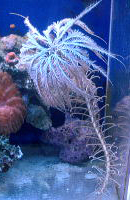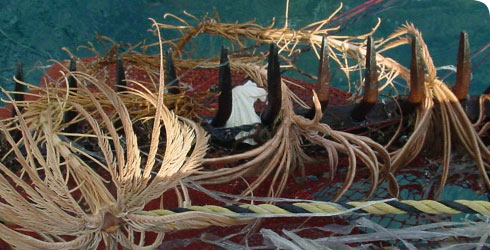Behaviour and ecology
Trophic strategy
- Metacrinus rotundus is a bottom-dwelling filter feeder.
- Crinoids feed mainly on plankton.

Metacrinus rotundus in an aquarium, showing the long stem and parabolic fan. © Marine Theatre Inc.
Behaviour
M. rotundus is a mainly sessile animal with the fan-like crown supported by a tether-like stem.
This sea lily is primarily suited to hard substrates, using its many cirri to attach itself to shell fragments and rocks.
The arms are arranged in a parabolic fan that faces into the prevailing water current. These arms have numerous rows of feather-like pinnules, which are covered in podia. The podia are shaped like small tenticles and bear long, slender, mucus-secreting papillae.
During feeding, food:
- becomes trapped in the mucus
- is tossed into the food groove by a sudden whip-like action
- is transported along the food groove to the mouth at the centre of the fan
Migration
Like many other crinoid species, M. rotundus has muscular articulations in the arms that allow the animal to crawl across the sea bed. However, this has only been observed in one shallow-dwelling species.
Associations
These crinoids occur in dense colonies on rocky substrates associated with a rich marine fauna of molluscs and brittle stars.
